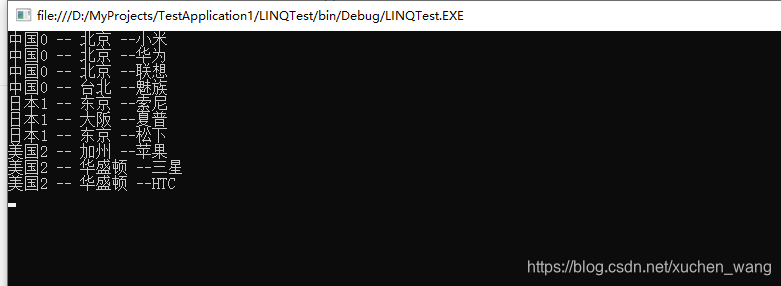本文主要用来记录、让自己有所了解和提升,以后遗忘时可以查看,关于SelectMany(),这篇文章写得不错,值得一看。
话不多说,先上代码看 Select()
public class Person
{public string Name { get; set; }public string Gender { get; set; }public int Age { get; set; }public List<Phone> Phones { get; set; }
}public class Phone
{public string Country { get; set; }public string City { get; set; }public string Name { get; set; }
}static void Main(string[] args)
{List<Person> PersonLists = new List<Person>(){new Person { Name = "张三",Age = 20,Gender = "男",Phones = new List<Phone> {new Phone { Country = "中国", City = "北京", Name = "小米" },new Phone { Country = "中国",City = "北京",Name = "华为"},new Phone { Country = "中国",City = "北京",Name = "联想"},new Phone { Country = "中国",City = "台北",Name = "魅族"},}},new Person { Name = "松下",Age = 30,Gender = "男",Phones = new List<Phone> {new Phone { Country = "日本",City = "东京",Name = "索尼"},new Phone { Country = "日本",City = "大阪",Name = "夏普"},new Phone { Country = "日本",City = "东京",Name = "松下"},}},new Person { Name = "克里斯",Age = 40,Gender = "男",Phones = new List<Phone> {new Phone { Country = "美国",City = "加州",Name = "苹果"},new Phone { Country = "美国",City = "华盛顿",Name = "三星"},new Phone { Country = "美国",City = "华盛顿",Name = "HTC"}}}};Console.WriteLine("这是该方法的第一种重载:");var firstLists = PersonLists.Select(p => p.Name);foreach (var List in firstLists){Console.WriteLine($"{List}");}Console.WriteLine("这是该方法的第二种重载,就是加了一个索引项参数:");var secondLists = PersonLists.Select((p, q) =>{return (q.ToString() + p.Name);});foreach (var List in secondLists){Console.WriteLine($"{List}");}Console.Read();
}运行效果如下图所示:

接下来再看SelectMany(),SelectMany()就比较牛逼了,官方解释为将序列的每个元素投影到 IEnumerable<TResult> 并将结果序列合并为一个序列,先看代码和运行效果,代码如下:
public class Person
{public string Name { get; set; }public string Gender { get; set; }public int Age { get; set; }public List<Phone> Phones { get; set; }
}public class Phone
{public string Country { get; set; }public string City { get; set; }public string Name { get; set; }
}static void Main(string[] args)
{List<Person> PersonLists = new List<Person>(){new Person { Name = "张三",Age = 20,Gender = "男",Phones = new List<Phone> {new Phone { Country = "中国", City = "北京", Name = "小米" },new Phone { Country = "中国",City = "北京",Name = "华为"},new Phone { Country = "中国",City = "北京",Name = "联想"},new Phone { Country = "中国",City = "台北",Name = "魅族"},}},new Person { Name = "松下",Age = 30,Gender = "男",Phones = new List<Phone> {new Phone { Country = "日本",City = "东京",Name = "索尼"},new Phone { Country = "日本",City = "大阪",Name = "夏普"},new Phone { Country = "日本",City = "东京",Name = "松下"},}},new Person { Name = "克里斯",Age = 40,Gender = "男",Phones = new List<Phone> {new Phone { Country = "美国",City = "加州",Name = "苹果"},new Phone { Country = "美国",City = "华盛顿",Name = "三星"},new Phone { Country = "美国",City = "华盛顿",Name = "HTC"}}}};var Lists = PersonLists.SelectMany(p => p.Phones);//此方法的第一个重载foreach (var list in Lists){Console.WriteLine($"{list.Country} -- {list.City} --{list.Name}");}Console.Read();
} selectMany可以将phones元素单独投影成为一个序列:![]() 。
。
运行效果如下所示:

SelectMany()的第二种重载是这样的:
public static IEnumerable<TResult> SelectMany<TSource, TResult>(this IEnumerable<TSource> source, Func<TSource, int, IEnumerable<TResult>> selector);保持初始化实体类数据不变,编写第二种重载的代码:
var Lists = PersonLists.SelectMany((p,i) => {p.Phones.ForEach(q => { q.Country += i.ToString(); });return p.Phones;});foreach (var list in Lists){Console.WriteLine($"{list.Country} -- {list.City} --{list.Name}");}Console.Read();其实无非是多了一个参数:索引,此索引为PersonLists的索引,上述代码会在Phone元素的Country属性中添加PersonLists的索引,返回类型依旧是![]() ,然后输出。运行效果如下图所示:
,然后输出。运行效果如下图所示:

SelectMany()的第三种重载是这样的:
public static IEnumerable<TResult> SelectMany<TSource, TCollection, TResult>(this IEnumerable<TSource> source, Func<TSource, IEnumerable<TCollection>> collectionSelector, Func<TSource, TCollection, TResult> resultSelector)看似十分复杂,无非就是返回一个自定义的匿名类,并且可以投影你想要的元素,编写第三种重载的代码:
var Lists = PersonLists.SelectMany(p => p.Phones,(p,q) => new { PersonName = p.Name,PhoneName = q.Name });
foreach (var List in Lists)
{Console.WriteLine($"{List.PersonName} -- {List.PhoneName}");
}
Console.Read();以上代码的返回类型是这样的:
运行结果如下图所示:

SelectMany()的第四种重载是这样的:
public static IEnumerable<TResult> SelectMany<TSource, TCollection, TResult>(this IEnumerable<TSource> source, Func<TSource, int, IEnumerable<TCollection>> collectionSelector, Func<TSource, TCollection, TResult> resultSelector)其实就是比第三种又多了一个PersonLists的索引而已,代码如下:
var Lists = PersonLists.SelectMany((p,i) =>
{p.Phones.ForEach(q => { q.Name += i.ToString();});return p.Phones;
},
(p,q) => new { PersonName = p.Name,PhoneName = q.Name });
foreach (var List in Lists)
{Console.WriteLine($"{List.PersonName} -- {List.PhoneName}");
}
Console.Read();运行结果如下图所示:











、Assembly.LoadFrom()、Assembly.LoadF ile ()方法)








